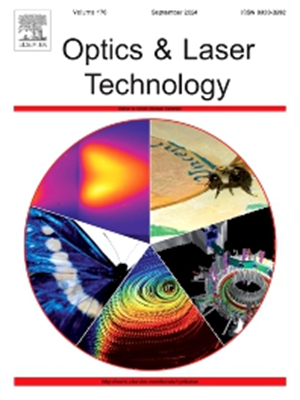基于可控光机械耦合和等离子体协同作用的芯片级硅光机械系统动态高阶分频控制
IF 5
2区 物理与天体物理
Q1 OPTICS
引用次数: 0
摘要
本研究提出了一种基于硅基光机械系统的片上分频调节方法,该方法集成了具有亚波长模式体积(≈0.051(λ/nair)3)的光子晶体(PhC)腔,利用双光子吸收(TPA)诱导的Drude电子空穴等离子体的强非线性耦合来实现动态高阶分频。实验中,通过调整光纤位置来控制机械自由度,同时实现10 nm以上的光共振波长调谐和亚纳米尺度的分频锁定(中心波长:1521.35 nm,光频率:197.06 THz)。结果表明,在约100 kHz的机械基频下,可以稳定地产生1/5、1/10和1/25电分频信号,并在分频路径之间动态切换。cmos兼容架构为光子分频器、片上时钟同步和高精度传感网络提供了可扩展的平台,推动了微纳光电器件的非线性功能设计。本文章由计算机程序翻译,如有差异,请以英文原文为准。
Dynamic high-order frequency division control in chip-scale silicon optomechanical systems via controllable optomechanical coupling and drude plasma synergy
This study proposes an on-chip frequency division regulation method for silicon-based optomechanical systems, integrating a photonic crystal (PhC) cavity with subwavelength mode volume (≈0.051(λ/nair)3), which leverages strong nonlinear coupling from two-photon absorption (TPA) induced Drude electron-hole plasma to achieve dynamic high-order frequency division. Experimentally, mechanical degrees of freedom are controlled by adjusting fiber positions, enabling simultaneous optical resonance wavelength tuning over 10 nm and sub-nanometer-scale frequency division locking (central wavelength: 1521.35 nm, optical frequency: 197.06 THz). Results demonstrate stable generation of 1/5, 1/10, and 1/25 electrical frequency division signals under a mechanical base frequency of ∼100 kHz, with dynamic switching between division paths. The CMOS-compatible architecture offers a scalable platform for photonic frequency dividers, on-chip clock synchronization, and high-precision sensing networks, advancing nonlinear functional design in micro-nano optoelectronic devices.
求助全文
通过发布文献求助,成功后即可免费获取论文全文。
去求助
来源期刊
CiteScore
8.50
自引率
10.00%
发文量
1060
审稿时长
3.4 months
期刊介绍:
Optics & Laser Technology aims to provide a vehicle for the publication of a broad range of high quality research and review papers in those fields of scientific and engineering research appertaining to the development and application of the technology of optics and lasers. Papers describing original work in these areas are submitted to rigorous refereeing prior to acceptance for publication.
The scope of Optics & Laser Technology encompasses, but is not restricted to, the following areas:
•development in all types of lasers
•developments in optoelectronic devices and photonics
•developments in new photonics and optical concepts
•developments in conventional optics, optical instruments and components
•techniques of optical metrology, including interferometry and optical fibre sensors
•LIDAR and other non-contact optical measurement techniques, including optical methods in heat and fluid flow
•applications of lasers to materials processing, optical NDT display (including holography) and optical communication
•research and development in the field of laser safety including studies of hazards resulting from the applications of lasers (laser safety, hazards of laser fume)
•developments in optical computing and optical information processing
•developments in new optical materials
•developments in new optical characterization methods and techniques
•developments in quantum optics
•developments in light assisted micro and nanofabrication methods and techniques
•developments in nanophotonics and biophotonics
•developments in imaging processing and systems

 求助内容:
求助内容: 应助结果提醒方式:
应助结果提醒方式:


